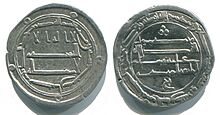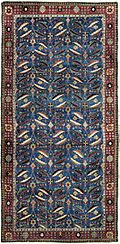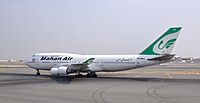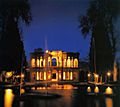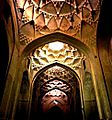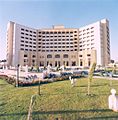Kerman facts for kids
Quick facts for kids
Kerman
Persian: کرمان
Kārmānia, Boutiā, Carmānia, Karmana
|
||
|---|---|---|
|
City
|
||
|
|
||
|
||
| Nickname(s):
ديار كريمان (Persian for "Land of Karimans"), The City of Stars
|
||
| Country | Iran | |
| Province | Kerman | |
| County | Kerman | |
| District | Central | |
| Founded | c. 3rd century AD | |
| Area | ||
| • City | 220 km2 (92.22 sq mi) | |
| Elevation | 1,755 m (5,758 ft) | |
| Population
(2016)
|
||
| • City | 537,718 | |
| • Urban | 738,374 | |
| • Population Rank in Iran | 10th | |
| Demonym(s) | Kermani | |
| Time zone | UTC+3:30 (IRST) | |
| Postal code |
761
|
|
| Area code(s) | +98 343 | |
| Main language(s) | Persian | |
| Climate | BWk | |
Kerman (Persian: كرمان; [kʲeɾˈmɒːn]) is a city in the Central District of Kerman County, Kerman province, Iran, serving as capital of the province, the county, and the district.
Contents
History
Kerman was founded as a defensive outpost, with the name Veh-Ardashir, by Ardashir I, founder of the Sasanian Empire, in the 3rd century AD. After the Battle of Nahāvand in 642, the city came under Muslim rule. At first the city's relative isolation allowed Kharijites and Zoroastrians to thrive there, but the Kharijites were wiped out in 698, and the population was mostly Muslim by 725. Already in the eighth century the city was famous for its manufacture of cashmere wool shawls and other textiles. The Abbasid Caliphate's authority over the region was weak, and power passed in the tenth century to the Buyid emirs. The region and city fell to Mahmud of Ghazni in the late tenth century. The name Kerman was adopted at some point in the tenth century.
Under the rule of the Seljuk Turks in the 11th and 12th centuries, Kerman remained virtually independent, conquering Oman and Fars. When Marco Polo visited Kerman in 1271, it had become a major trade emporium linking the Persian Gulf with Khorasan and Central Asia. Subsequently, however, the city was sacked many times by various invaders. Kerman expanded rapidly during the Safavid dynasty. Carpets and rugs were exported to England and Germany during this period.
In 1793 Lotf Ali Khan defeated the Qajars, and in 1794 he captured Kerman. But soon after he was besieged in Kerman for six months by Agha Mohammad Khan Qajar. When the city fell to Agha Mohammad Khan, angered by the popular support that Lotf Ali Khan had received, many of the male inhabitants were killed or blinded, and a pile was made out of 20,000 detached eyeballs and poured in front of the victorious Agha Mohammad Khan. Many women and children were sold into slavery, and in 90 days the city turned into ruins. However, the Zoroastrians of Kerman who had been strong supporters of Lotf Ali Khan suffered the wrath of the founder of Qajar dynasty the most during this period.
The present city of Kerman was rebuilt in the 19th century to the northwest of the old city, but the city did not return to its former size until the 20th century.
Demographics
Ethnicity and religion
The people of Kerman are Persians, and most are Muslim. Kerman is a religious conservative city. Kerman has a small Zoroastrian minority.
Population
The population of the city in 1996 was 385,000. At the time of the 2006 National Census, the city's population was 496,684 in 127,806 households. The following census in 2011 counted 534,441 people in 147,922 households. The 2016 census measured the population of the city as 537,718 people in 162,677 households.
It is the largest and most developed city in the province and one of the most important cities in southeastern Iran. It is also one of the largest cities of Iran in terms of area. Kerman is famous for its long history and strong cultural heritage. The city is home to many historic mosques and Zoroastrian fire temples. Kerman has been the capital city of Iranian dynasties several times during its history. It is located on a large, flat plain, 800 km (500 mi) south-east of Tehran, the capital of Iran.
Population development
Some of these figures are estimates only, official census results are indicated with (¹).
|
|
¹ official census results
Geography
Surrounding municipalities
Northwest = Anar/North = Ravar/Northeast = Shahdad/West = Rafsanjan/Center = Kerman/South = Jiroft/Southwest = Sirjan/Southeast = Mahan/East = Bam
Kerman is located on a high margin of Kavir-e Lut (Lut Desert) in the south-central part of Iran. The city is surrounded by mountains. Kerman is also located along the Saheb Al Zaman mountain. The city is 1,755 m (5,758 ft) above sea level, making it third in elevation among provincial capitals in Iran. Winter brings very cold nights to Kerman. Mountains in the south and southeast Jftan Joopar and Plvar and Kerman have snow all year round. Kerman is located at latitude 30.29 and longitude 57.06.
Climate
Kerman has a cold desert climate (BWk, according to the Köppen climate classification), with hot summers and cool to cold winters. Precipitation is scarce throughout the year.
The city's many districts are surrounded by mountains. The northern part of the city is located in an arid desert area, while the highland of the southern part of the city enjoys a more moderate climate.
The city of Kerman has a moderate climate. The average annual rainfall is 148 mm. Otherwise, its climate is relatively cool (by Iranian standards).
| Climate data for Kerman – Altitude: 1753.8 m (1951–2010, records 1951–2020) | |||||||||||||
|---|---|---|---|---|---|---|---|---|---|---|---|---|---|
| Month | Jan | Feb | Mar | Apr | May | Jun | Jul | Aug | Sep | Oct | Nov | Dec | Year |
| Record high °C (°F) | 24.4 (75.9) |
29.4 (84.9) |
32.9 (91.2) |
35.0 (95.0) |
38.8 (101.8) |
41.6 (106.9) |
42.0 (107.6) |
42.3 (108.1) |
39.0 (102.2) |
35.0 (95.0) |
31.1 (88.0) |
28.0 (82.4) |
42.3 (108.1) |
| Mean daily maximum °C (°F) | 12.2 (54.0) |
14.9 (58.8) |
19.0 (66.2) |
24.4 (75.9) |
30.1 (86.2) |
35.0 (95.0) |
35.8 (96.4) |
34.4 (93.9) |
31.5 (88.7) |
26.1 (79.0) |
19.6 (67.3) |
14.4 (57.9) |
24.8 (76.6) |
| Daily mean °C (°F) | 4.6 (40.3) |
7.3 (45.1) |
11.4 (52.5) |
16.4 (61.5) |
21.2 (70.2) |
25.6 (78.1) |
26.8 (80.2) |
24.6 (76.3) |
21.1 (70.0) |
15.9 (60.6) |
10.0 (50.0) |
5.9 (42.6) |
15.9 (60.6) |
| Mean daily minimum °C (°F) | −3.1 (26.4) |
−0.3 (31.5) |
3.8 (38.8) |
8.3 (46.9) |
12.4 (54.3) |
16.2 (61.2) |
17.8 (64.0) |
14.8 (58.6) |
10.7 (51.3) |
5.7 (42.3) |
0.4 (32.7) |
−2.6 (27.3) |
7.0 (44.6) |
| Record low °C (°F) | −30.0 (−22.0) |
−20.0 (−4.0) |
−10.2 (13.6) |
−3.0 (26.6) |
1.0 (33.8) |
7.0 (44.6) |
8.0 (46.4) |
2.0 (35.6) |
−1.0 (30.2) |
−10.0 (14.0) |
−15.0 (5.0) |
−25.0 (−13.0) |
−30.0 (−22.0) |
| Average precipitation mm (inches) | 28.8 (1.13) |
25.2 (0.99) |
33.1 (1.30) |
18.7 (0.74) |
10.8 (0.43) |
1.1 (0.04) |
1.4 (0.06) |
0.5 (0.02) |
0.3 (0.01) |
1.5 (0.06) |
5.6 (0.22) |
21.0 (0.83) |
148 (5.83) |
| Average snowfall cm (inches) | 3.7 (1.5) |
1.0 (0.4) |
0.1 (0.0) |
0.0 (0.0) |
0.0 (0.0) |
0.0 (0.0) |
0.0 (0.0) |
0.0 (0.0) |
0.0 (0.0) |
0.0 (0.0) |
0.0 (0.0) |
2.6 (1.0) |
7.4 (2.9) |
| Average precipitation days (≥ 1.0 mm) | 4.2 | 4 | 4.7 | 3.2 | 1.5 | 0.1 | 0.2 | 0.2 | 0.1 | 0.6 | 1.4 | 3 | 23.2 |
| Average rainy days | 4.7 | 5.3 | 6.7 | 4.5 | 1.9 | 0.4 | 0.3 | 0.4 | 0.1 | 0.9 | 2.6 | 3.6 | 31.4 |
| Average snowy days | 2.2 | 1.0 | 0.4 | 0 | 0 | 0 | 0 | 0 | 0 | 0 | 0.1 | 1.0 | 4.7 |
| Average relative humidity (%) | 53 | 46 | 41 | 34 | 26 | 19 | 19 | 20 | 21 | 28 | 37 | 48 | 33 |
| Average dew point °C (°F) | −10.3 (13.5) |
−9.4 (15.1) |
−8.5 (16.7) |
−6.1 (21.0) |
−5.7 (21.7) |
−6.1 (21.0) |
−5.1 (22.8) |
−6.1 (21.0) |
−7.6 (18.3) |
−7.8 (18.0) |
−9.1 (15.6) |
−10.4 (13.3) |
−7.7 (18.2) |
| Mean monthly sunshine hours | 198.4 | 200.0 | 223.5 | 237.5 | 298.0 | 323.6 | 339.1 | 337.5 | 310.3 | 283.9 | 241.9 | 206.4 | 3,200.1 |
| Source 1: IRIMO | |||||||||||||
| Source 2: NOAA(precipitation days - dew point 1991-2020, snowfall 1981-2010) | |||||||||||||
Geological characteristics
For Iranian paleontologists, Kerman has always been considered a fossil paradise. The discovery of new dinosaur footprints in 2005 renewed hopes for better understanding the history of this area.
Economy
The economy of Kerman is mostly based on farming, notably nut farming and also mining.Pistachios are an important part of the economy in Kerman.
Carpet weaving is one of the main industries of the city, and the carpets produced there are renowned internationally. Carpet weaving is a very old tradition in Kerman. The oldest carpet discovered in Kerman, dates from about 500 years ago. Cotton textiles and goats-wool shawls are also manufactured.
A number of modern establishments such as textile mills and brickworks also have been constructed. The province's mineral wealth includes copper and coal.
Culture
The only Iranian anthropology museum dedicated to Zoroastrianism is located in the Kerman's Fire Temple, showcasing the ancient history of Zoroastrians. The idea of launching the museum along with the library of Kerman's Zoroastrian Society came to light in 1983, when the head of the society, Parviz Vakhashouri, and the former head of the library, Mehran Gheibi, collected cultural heritage artifacts of Kerman's Zoroastrian community. These two officials added many other objects to this collection. The museum was officially inaugurated during Jashn-e Tirgan in 2005 by Iran's Cultural Heritage, Handicrafts and Tourism Organization (ICHHTO).
Jashn-e Tirgan or Tiregan is an ancient Iranian rain festival observed on July 1. The festivity refers to archangel Tir (literally meaning arrow) or Tishtar (lightning), who appear in the sky to generate thunder and lightning for providing much needed rain.
The Sadeh ceremony is celebrated every year in Kerman.
Also, the archeological ancient areas of Jiroft and Tappe Yahya Baft are located south of Kerman. Rayen Castle is also located in Rayen town, southeast of Kerman.
Some of the handicrafts and souvenirs of the province of Kerman are traditional embroidery known as pateh, carpets, rugs, jajeems, kilims (a coarse carpet), satchels, and other hand woven articles. Caraway seeds and pistachios from Rafsanjan, Zarand, and Kerman are best of the main items of this province.
Sport
The city is home to athletic teams representing different sports. Mes Kerman is the major football team of the city. It was promoted to Iran's top league, the Persian Gulf Pro League, in the 2005–06 season. The team is named after and sponsored by Kerman's copper industries. This team has a history of participating in the AFC Champions League. The team now competes in the Azadegan League.
- MES handball team is in the top league.
- MES cycling team is in the top league of cycling in the country.
- MES chess team is in the first league of the country.
- The city's baseball team, known as the Boshra Baseball Academy, won the country's baseball cup for the first time in 2013.
Kerman sport venues
- 15,000-seat Shahid Bahonar Stadium
- 30,000-seat dedicated MES soccer team stadium (under construction)
- Salimi Kia Stadium
- Sports Complex of Imam Ali
- Sirch Ski Resort
- International Kart racing track
Media
Kerman is the media hub of the Kerman Province. Newspapers are published in the city, such as Kerman Emruz (Kerman Today) and Bidari. Hadis–Pasargad is a weekly newspaper. Kerman has a 24-hour TV channel known as the Kerman Channel or Channel 5. The city also has a radio station.
Transportation
Kerman is on the Tehran, Bandar Abbas and Zahedan route. Ayatollah Hashemi Rafsanjani Airport is considered one of Iran's main airports. It has daily and weekly flights to Tehran, Ahwaz, Yazd, Esfahan, Bandar Abbas, Mashhad and Shiraz. Also, the Trans-Iranian Railway passes through this city. Kerman's newly built bus terminus, Adineh, opened in May 2013.
Metro and Tram
Kerman's Metro had been approved by the government cabinet and was meant to cover large parts of the metropolitan area in Kerman, but the project's operations were cancelled due to several issues.
Chabahar–Zahedan Railway
In May 2016, during Indian Prime Minister Narendra Modi's trip to Iran, agreement was signed to develop two berths at Port of Chabahar and to build new Chabahar–Zahedan railway, as part of North–South Transport Corridor, by Indian Railways' public sector unit Ircon International.
Colleges and universities
- Kerman Azad University
- Shahid Bahonar University of Kerman is one of technological institutions of Kerman province
- Kerman University of Medical Sciences is the a medical university
- Kerman Graduate University of Technology is a graduate-level degree-granting institution.
- Shahid Chamran Technical College of Kerman
- Payam Noor University of Kerman
- Kerman Khaje-Nasir Higher Education Center
Notable people
- Al-Mahani (9th century mathematician and astronomer)
- Khwaju Kermani (14th century poet from the 14th century)
- Shah Nimatullah Wali (14th century Sufi Master and poet)
- Ganj Ali Khan (16th century Kurdish governor of Kerman.
- Mirza Reza Kermani (Iranian revolutionary who assassinated the Shah of Persia)
- Qasem Soleimani (Commander of the Qods Force, a division of the Iranian Islamic Revolutionary Guard Corps)
- Mohammad Javad Bahonar (the Prime minister of Iran from 15 to 30 August 1981 when he was assassinated by Mujahideen-e Khalq)
- Mohammad-Reza Bahonar (the conservative First Deputy Speaker of the Parliament of Iran)
- Mohammad Mehdi Zahedi (the former Iranian minister of Science and Technology and Mathematics full professor)
- Majid Namjoo (Iranian politician who was the Minister of Energy in the 9th government)
- Mohammad Ebrahim Bastani Parizi
- Houshang Moradi Kermani (writer)
- Keikhosrow Shahrokh
- Peyman Soltani, conductor of Melal Orchestra
- Saeed Nafisi (writer)
- Arash Borhani (soccer player)
- Zahra Nemati (paralympic archery gold medalist at the 2012 Summer Paralympics, 2016 Summer Paralympics, 2020 Summer Paralympics)
- Roohollah Khaleghi
- Ali Movahedi-Kermani
- Mahnaz Afkhami (women's rights activist )
- Ahmad Madani (Iranian politician, Commander of Iranian Navy (1979))
- Javad Nurbakhsh, previous Master of the Nimatullahi Sufi Order)
- Ahmadreza Ahmadi
- Mozzafar Baghai
- Ali Akbar Abdolrashidi
- Parviz Shahriari (mathematician, author, translator and political activist)
- Tahereh Saffarzadeh, poet and writer
- Yahya Kamalipour was born in 1947 in the city of Ravar in Kerman province. He had the idea of starting a global media magazine in his mind since 1999 and before he became the director of the communications department. In that year, he shared his idea with the then director of the communication group, but he did not show much interest in this project. But when he was appointed to manage the communication group, he was able to implement this idea and in the fall of 2002, the first edition of the World Media Magazine was placed on the Internet
Twin towns – sister cities
 Armavir, Armenia
Armavir, Armenia
Gallery
-
Kerman's Grand Bazaar
See also
 In Spanish: Kermán para niños
In Spanish: Kermán para niños









